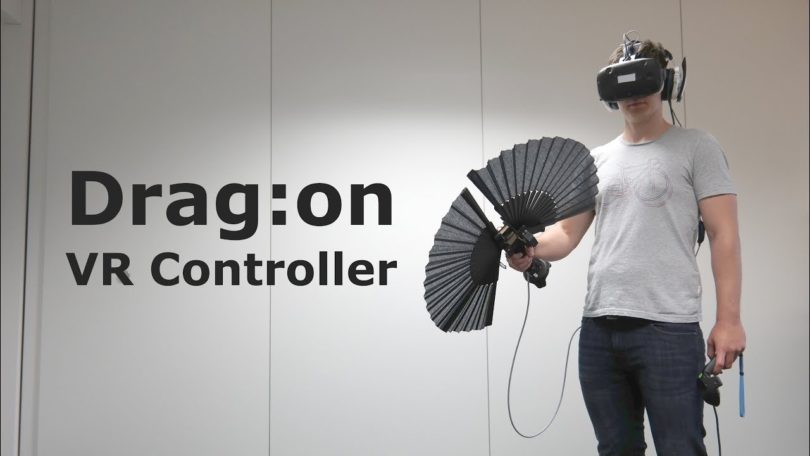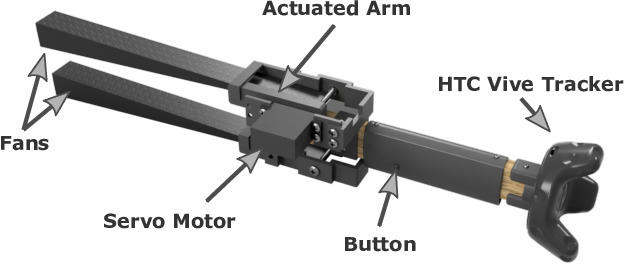Drag:on VR Controller Provides Haptic Feedback Based on Drag and Weight Shift
Standard virtual reality controllers are perfect for interacting with and manipulating objects in virtual reality environments but they lack the sophistication to translate realistic and kinesthetic impression of features such as sizes, resistance, weight and inertia which are often rendered through vibrational feedback.

Virtual reality experience is mostly a visual and audio experience so you will be able to see and hear everything that happens in the simulated environment. However, there are various sensations that are lacking in VR such as the sense of smell, taste or touch.
This is about to change. Engineers at the Research Center for Artificial Intelligence in Germany have designed a new virtual reality controller which can convey the kinesthetic impressions through the use of a unique fan shape. The virtual reality controller will be able to convey the sensation of weight in virtual reality which could have a transformative impact in how we experience VR.
The concept and implementation is known as Drag:on and offers an ungrounded shape-changing virtual reality controller which delivers a dynamic passive haptic feedback based on a combination of air resistance or weight shift or drag.
The engineers Antonio Kruger and Andre Zenner developed the shape-changing Drag:on VR controller concept by capitalizing on the weight shifting and airflow to generate haptic feedback. When this happens, it creates the feeling of the object size and movement when the object is handled in VR.
The VR controller manipulates both drag and the rotational inertia felt by the user by dynamically adjusting its surface area. The concept enabled Drag:on to provide distinguishable degrees of haptic feedback. The Drag:on prototype is able to increase haptic realism in virtual reality compared to the current standard controllers. When it is swung or rotated, it will generate the perception of virtual resistance. It is through this mechanism that Drag:on generates haptic feedback that can be used in rendering different types of virtual mechanical resistances, virtual gas streams as well as virtual objects in various degrees of scale and material. The Drag:on controller could self-transform through various actuators in order to increase or decrease its surface area along with the mass distribution. This enabled it to adapt to virtual interactions with various objects.
There are other serious efforts to develop haptic feedback for the VR sphere. Haptic feedback plays a very crucial role in the virtual reality experience by adding a physical layer to the immersive experience that allows the player to feel digital objects in virtual reality environments.
When a user hits an object using their virtual hands, the haptic controllers will promptly vibrate to create a sensation of two objects colliding. Haptic controllers are developing rapidly, utilizing either vibrations or piezoelectric sensors. However, the standard controllers still can’t give users the sensation of resistance or the ability to feel the weight of varied sizes of objects in virtual reality.
Creating Haptic Feedback and Weight in Virtual Reality
The two engineers at the Research Center for Artificial Intelligence developed a unique virtual reality controller which utilizes a dual folding fan-like system that can open or close in different configurations depending on what is happening in the simulated virtual reality environment. This is the process through which it generates both dynamic and passive haptic feedback. In layman’s terms, the researchers have succeeded in creating the sensation of an artificial weight in virtual reality environment through a process of drag and weight shifting.
The two engineers, Andre Zenner and Antonio Kruger, recently published a paper which outlines their work. The two first explored this concept two years ago using a stick-like device known as Shifty.
This initial concept was a virtual reality controller that utilized an internal weight moving back and forth to generate an illusion of weight.
When you pick an item in VR, the internal weight will shift forward thereby creating a feeling of “heaviness” in the virtual object. If the object is bigger, the weight would extend even further making it feel heavier. If you release the object, the weight retracts to the handle.
Evolution into the Drag:on
This evolved into the current Drag:on VR controller. Rather than an internal weight that moves back and forth, the engineers have created a controller which utilizes a combination of 3D printed parts along with a single button for activating the controller, the HTC Vive Tracker, two MG996R servo motors for actuation function and finally, two semi-large folding fans which are capable of opening up to an area of 650% of their actual size within a duration of 570ms to generate the drag.

When a user grabs a virtual object with weight such as a small rock, the folding fans in the Drag:on VR controller opens up and creates air resistance as you are picking up the rock. If the rock is bigger, the fans will open up even further thereby creating more resistance and making the virtual rock to appear heavier. The folding fans look like some futuristic version of tennis racket when it is fully opened.
The researchers tested five different virtual reality scenarios using the Drag:on VR controller:-
- Perception of Virtual Object Scales: This scenario looks at the creation of resistance and weight where a user holds different-sized digital signs and then waves them back and forth in virtual reality. In this scenario, the smaller signs got the least resistance while the larger signs caused more drag in the handset as the fans were opened much wider.
- Perception of VR Object Materials: This scenario is similar to the Virtual Object Scales. The digital object in this case was a shovel rather than a flat sign. Just like in the previous scenario, the fan opened wider if the shovel was heavier.
- Perception of Virtual Gas Flows: The user holds a virtual board closer to the opening that has air blowing out of it. When the board is moved closer to the opening, the fan opens and the user feels the resistance of the air which is pushing against the board. If the board is moved up and down near the source of the flowing air, the user will feel the shift of resistance from the top to the bottom as the folding fans open and close at various points.
- Perception of Virtual Ratchet Resistance: This scenario lets the user grab a tool in virtual reality to loosen or tighten a bolt. As the user turns the tool in order to tighten the bolt, the fans open to cause more resistance. When they loosen the bolt, the fans close and gives the user the feeling that the bolt is loosening.
- Perception of Virtual Wagon Weights: This scenario entailed pushing or pulling a heavy object in virtual reality. As the user pushes or pulls, the fans will either open or close to generate either drag or resistance. If the user pushes this hard and quickly, the fans open up to generate more resistance.
The tests determined that the subjects who tried out the Drag:on virtual reality controllers were able to experience a genuine sensation of weight and resistance when they were handling digital objects. The Drag:on project is still under development and it is not yet clear whether a consumer version will eventually hit the market.
https://virtualrealitytimes.com/2019/07/21/dragon-vr-controller-provides-haptic-feedback-based-on-drag-and-weight-shift/https://virtualrealitytimes.com/wp-content/uploads/2019/07/DragOn-VR-600x338.jpghttps://virtualrealitytimes.com/wp-content/uploads/2019/07/DragOn-VR-150x90.jpgHapticsStandard virtual reality controllers are perfect for interacting with and manipulating objects in virtual reality environments but they lack the sophistication to translate realistic and kinesthetic impression of features such as sizes, resistance, weight and inertia which are often rendered through vibrational feedback. Virtual reality experience is mostly a visual...Sam OchanjiSam Ochanji[email protected]EditorVirtual Reality Times - Metaverse & VR
